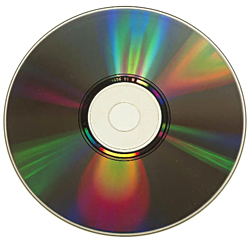DK Science: Digital Electronics
The simplest kind of electronics, known as analogue electronics, works with continuous signals – a smoothly rising and falling sound wave goes through an analogue circuit as a smoothly rising and falling voltage. Digital electronics works differently. Using SAMPLING, it converts signals into strings of numbers that can be processed mathematically by electronic circuits.
The wiggly grooves of a record mimic the shape of the original sound wave. The pick-up produces an electrical wave the same shape as the wiggles. Unfortunately, it copies faithfully everything it finds on the disc – so scratches come out as noisy clicks.

The surface of a CD looks nothing like the original sound waves. Before sound is put on a CD, digital electronic circuits convert it into complicated on–off patterns, which are pressed into the plastic as a series of pits. The patterns allow the CD player to play just the music and leave out the scratches.
Before a signal can be handled by digital electronics, it has to be converted into digital form. In sampling, circuits called analogue-to-digital converters make thousands of measurements of the signal each second. The measurements are then converted into binary form, which is a way of writing numbers with just two digits – ideal for on–off electronic switches.

Digital sound starts with a electrical circuit that samples an analogue sound signal about 44,000 times each second. This rate of sampling is needed to capture the highest frequencies (speeds of vibration) in the original sound wave. The circuit stores the value of each sample for just 20 millionths of a second – the time it takes to convert it into binary form.
The numbers from the sampled sound wave are handled in binary code, which uses only two digits – 1 and 0. In electronics, the corresponding code is “on” and “off”. Samples in this form can be sent as pulses. On a CD, samples use a complex error-correcting code to make the CD more resistant to scratches.
Sampling is not limited to sound. It is used to convert the picture in a camera phone into digital form. The picture is sliced into thousands of tiny square samples, called pixels. A small computer inside the phone works on the samples to produce a simplified picture, which can be sent to someone else more quickly than the original picture. Their phone changes the samples back into a picture again.
Pocket calculators would not be possible without digital electronics. They handle numbers as electrical signals that are either on or off. This is because they do their maths with transistors – electronic switches that, like other switches, can only turn on or off. Numbers in this form can easily be processed by the calculator’s LOGIC CIRCUITS to produce the right result.
Computers function by breaking big problems down into thousands of smaller ones. They then solve these little problems one by one until the job is done. All the actual work is done by logic gates – circuits that obey the rules of logic. Each logic gate obeys a single, simple rule, such as saying that C is true only if A and B are true. With enough gates, computers can solve any problem that is strictly logical. Most of the millions of transistors at the heart of a computer are in logic gates.
The large, complex chips in digital circuits are often supported by smaller logic chips. Each of these devices contains only a few logic gates. The gates are made from transistors and resistors formed on the surface of silicon.
Logic signals turn on (1) and off (0) to signal true and false. Gates have any number of inputs, but only one output. An inverter always has one input. Here are two examples of logic gates.
A binary system was known in ancient China, but mathematician Gottfried Leibniz wrote about it in 1703. He was, however, mainly interested in its philosophical meaning because, before computers, it was not of much practical use. Leibniz was also one of the inventors of calculus, a branch of mathematics that is very important in science.
